Ever wondered how to transform your apartment into a serene sanctuary where calm and clarity reign supreme? Minimalist living rooms have become wildly popular for their ability to create peaceful, clutter-free environments that feel spacious and inviting. With busy lifestyles and limited space, many are turning to minimalist design to simplify their surroundings and boost mental well-being, proving that less truly is more.
In this article, you’ll discover a treasure trove of inspiring ideas and practical tips to craft the perfect minimalist living room in your apartment. From calming color palettes and clever storage solutions to sleek furniture and subtle decor accents, we’ll guide you through a variety of styles and strategies that promote tranquility and organization. Whether you’re starting fresh or refreshing your current setup, these ideas will help you achieve a harmonious space that radiates calm and clarity.
1. Opt for Neutral Color Palettes to Foster Tranquility

Creating a calm and clutter-free living space starts with choosing the right colors, and neutral palettes are the cornerstone of minimalist serenity. Soft shades like warm beige, cool gray, creamy white, and muted taupe evoke a sense of peace and balance, making your living room feel open and inviting. These hues serve as a blank canvas, allowing your furniture and decor to stand out subtly without overwhelming the senses. The calming effect of neutrals promotes relaxation, helping your mind unwind after a busy day, making your space feel like a true retreat.
Visualize a living room bathed in gentle tones: walls painted a soft, matte dove gray, complemented by a plush, light beige sofa accented with a textured cream throw blanket. Natural wood accents, such as a light oak coffee table and simple shelving, add warmth and depth. The overall aesthetic is airy and cohesive, with textiles like linen curtains and woven rugs contributing tactile softness. The space feels peaceful, with minimal visual noise, encouraging a sense of calm and clarity that makes everyday living feel more centered.
To achieve this look, start by selecting a neutral color scheme for your walls, larger furniture pieces, and major textiles. Use painter’s tape and high-quality matte paint for a smooth, flawless finish. Incorporate furniture with clean lines in shades of gray, ivory, or taupe—think a sleek sectional or low-profile coffee table. For small decor touches, choose ceramic vases, woven baskets, or soft cotton cushions in matching tones. Keep accessories minimal, focusing on quality over quantity, and avoid bright or contrasting colors to preserve the tranquil atmosphere.
2. Incorporate Hidden Storage Solutions to Reduce Clutter
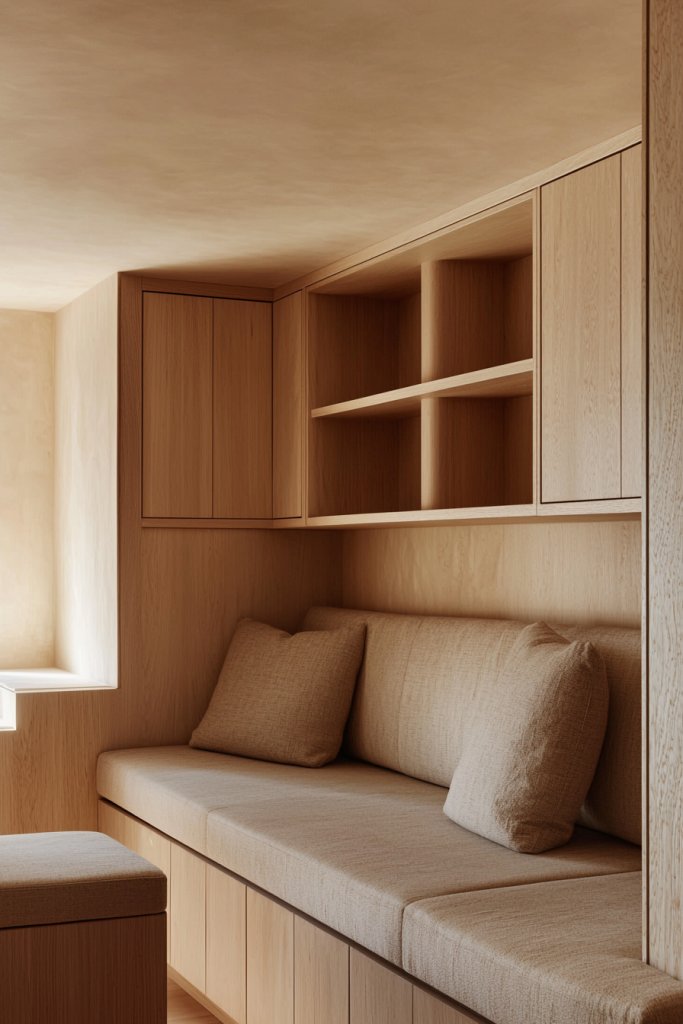
A clutter-free space is fundamental to minimalist living, and clever hidden storage is your best friend for maintaining calm and order. By integrating discreet compartments and multifunctional furniture, you can keep everyday essentials out of sight while maintaining a sleek, streamlined look. This approach eliminates visual chaos, making your living room appear larger and more serene. Hidden storage not only preserves your aesthetic but also helps you stay organized effortlessly, creating a space that promotes clarity and relaxation.
Imagine a low-profile media console with built-in drawers, or a coffee table with a secret compartment beneath its surface, perfect for stashing remote controls, magazines, or extra throws. You might also opt for a storage ottoman upholstered in soft fabric that doubles as extra seating or a footrest. Wall-mounted cabinets with push-to-open doors provide additional space for books, decor, or electronics, all while keeping surfaces clear. These solutions seamlessly blend function with form, ensuring your living room remains calm and clutter-free.
Getting started is simple: first, identify items that tend to pile up—such as magazines, toys, or electronics—and designate specific hidden spaces for them. Choose furniture pieces with built-in storage, like a sofa with under-seat compartments or a sleek TV unit with concealed drawers. Use decorative baskets or fabric bins inside cabinets for smaller items. When organizing, group similar items together and regularly declutter to prevent accumulation. With minimal effort, your living room will look pristine and inviting, with everything you need cleverly tucked away.
3. Select Sleek, Low-Profile Furniture for a Spacious Feel
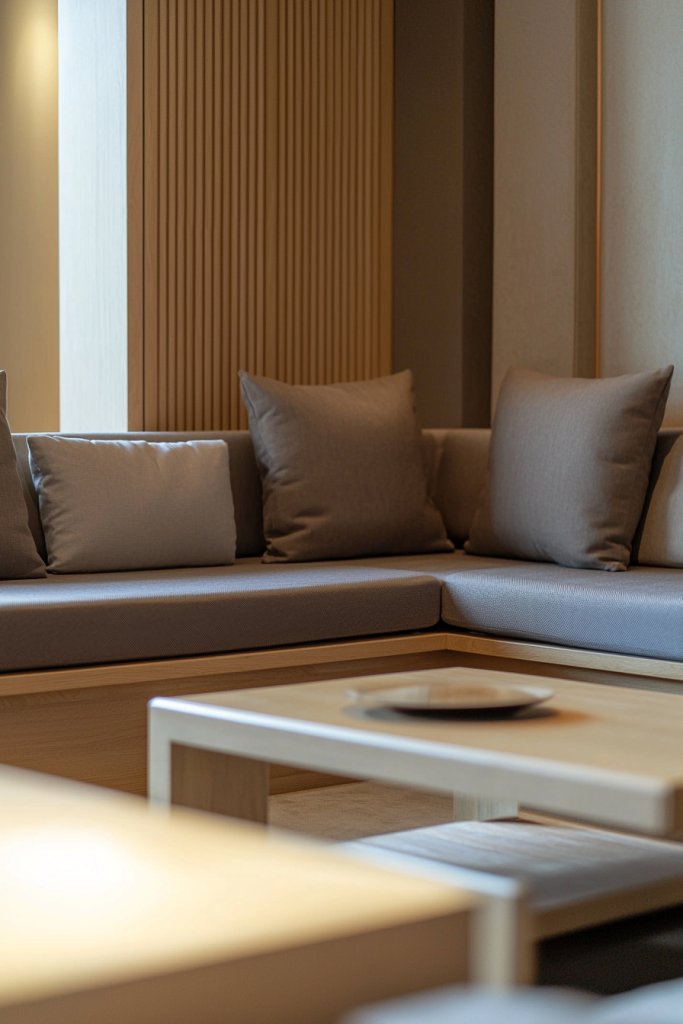
In a minimalist apartment, furniture that sits low and features clean, simple lines can dramatically enhance the sense of space. Low-profile pieces, such as a platform sofa or a slender coffee table, prevent the room from feeling crowded and help maintain open sightlines. This furniture style creates an airy, uncluttered environment by emphasizing horizontal lines and reducing visual weight, making your living room feel larger and more expansive.
Picture a streamlined, modular sofa with slim metal legs and a thin, cushioned seat in a neutral tone, paired with a minimalist wooden coffee table that’s barely above ground. The furniture’s sleek silhouette invites your eye to flow across the room without interruption, while textured textiles like a woven rug and soft throws add tactile warmth. The overall ambiance is calm and uncluttered, with ample space for movement and a clear focus on simplicity. The furniture’s understated elegance helps foster a sense of clarity and peacefulness.
To implement this, opt for furniture with low profiles—think sofas no taller than 30 inches, and tables with slim legs and smooth surfaces. Prioritize pieces made from light woods, matte metals, or upholstered in soft fabrics, avoiding bulky or ornate designs. Keep the scale proportional to your room size; in smaller spaces, choose multi-purpose pieces like a low storage ottoman. Arrange furniture to promote open pathways, and resist the urge to fill every corner—less is more. This approach ensures your living room feels spacious, calm, and effortlessly stylish.
4. Use Multi-Functional Furniture to Maximize Space Efficiency

Maximizing space in a small apartment demands smart, multi-purpose furniture that serves more than one function. By choosing versatile pieces, you can reduce clutter and maintain a clean, organized look while optimizing every square inch. Multi-functional furniture not only adds practicality but also keeps your living room feeling open and calm, perfect for a minimalist aesthetic that celebrates simplicity and efficiency.
Envision a sleek sofa bed that transforms from seating during the day to a cozy sleeping space at night, or a fold-out wall desk that can be tucked away when not in use. A storage bed with drawers beneath the mattress can hold linens or clothing, while nesting side tables can be combined or separated as needed. These pieces streamline your space, offering both comfort and utility without sacrificing style. The variety and adaptability of these furnishings create a seamless, clutter-free environment that feels calm and uncluttered.
Start by identifying your most-used functions—sleeping, working, entertaining—and look for furniture that can easily switch roles. Search for items like a convertible sofa, extendable dining tables, or stackable chairs. Use space-saving accessories such as foldable shelves or collapsible storage cubes, which can be stored away when not in use. When arranging, keep pathways clear and avoid overcrowding, allowing your living room to breathe. Multi-functional furniture transforms your compact space into a flexible, serene haven where every piece has a purpose.
5. Embrace Open Floor Plans with Clear Pathways
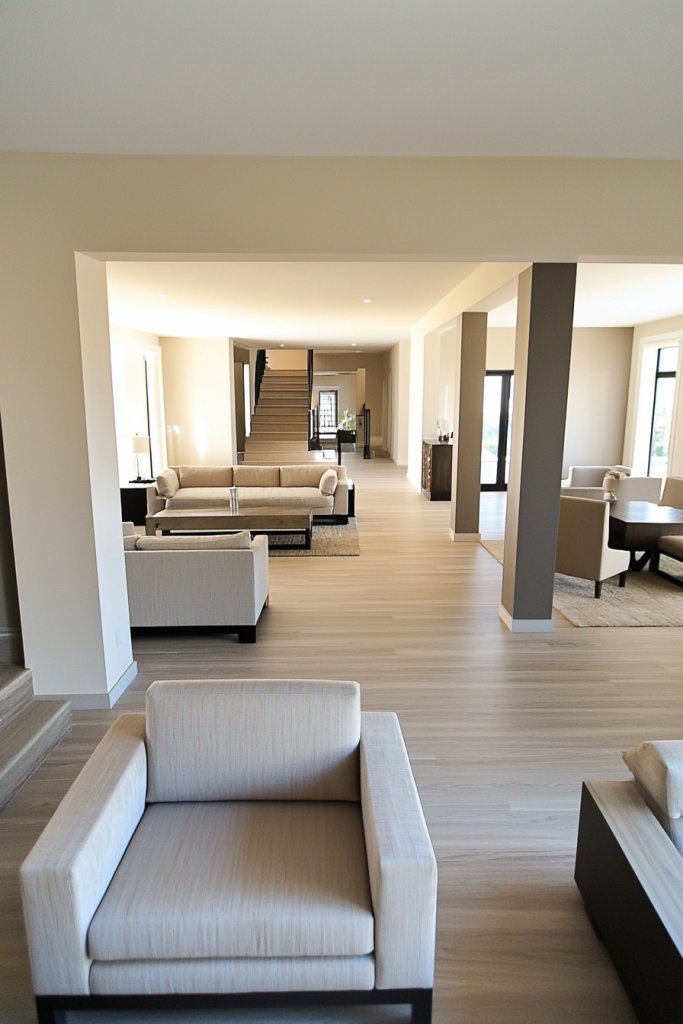
An open floor plan is essential for creating a sense of spaciousness and flow in a minimalist living room. By removing unnecessary walls and clutter, you foster an environment where movement feels natural and unconfined. Clear pathways allow light to circulate freely, enhance visual clarity, and make the entire space feel larger, fostering the calm and clarity that minimalist living aims to achieve.
Imagine a living room with a seamless flow from the entryway to the sitting area, with minimal furniture blocking sightlines. A neutral-toned sectional sofa anchors the space, while a simple area rug defines the seating zone without crowding the room. Keep furniture arrangement sparse and strategic—placing larger pieces against walls and leaving open space in the center. The absence of visual barriers invites light and air to move freely, making your apartment feel expansive and inviting. This layout encourages a relaxed, clutter-free lifestyle centered on simplicity.
To create this effect, start by decluttering and removing non-essential furniture. Arrange your seating to maximize openness, such as a sectional along one wall or a pair of slim chairs with a small table between them. Use area rugs to subtly delineate zones without creating visual clutter. Keep pathways at least 24 inches wide for ease of movement. Finally, choose furniture in neutral shades and simple shapes to maintain a cohesive, airy aesthetic that promotes calm and clarity throughout your space.
6. Add Soft, Textured Textiles for Comfort Without Overcrowding
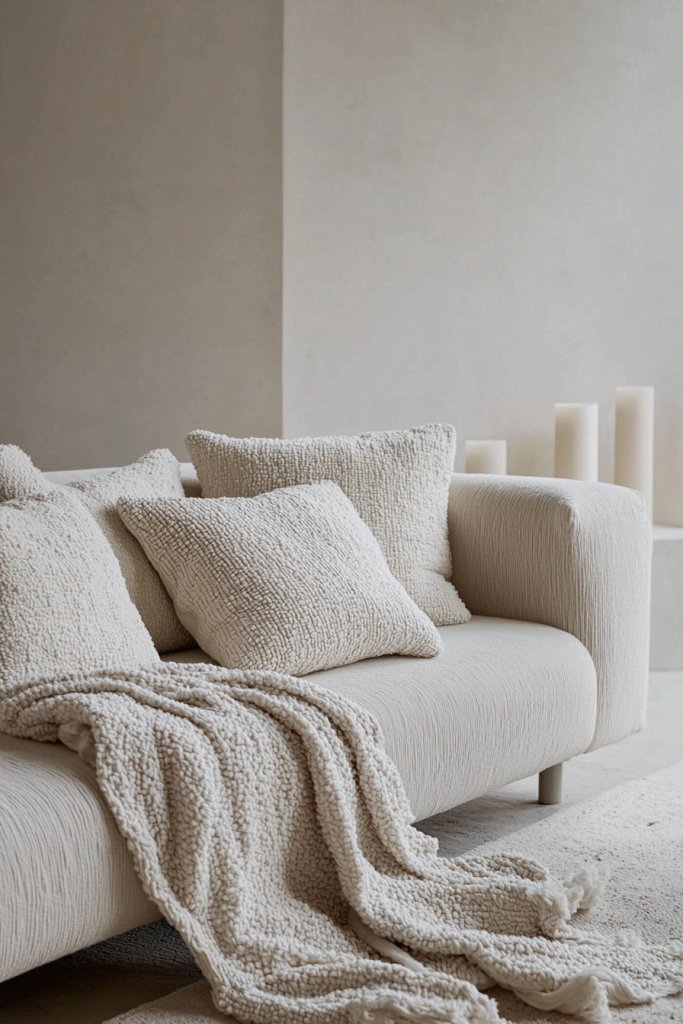
Creating a cozy, inviting living space doesn’t mean cluttering your minimalist apartment with bulky items. Instead, thoughtfully chosen textiles can add warmth and tactile interest without overwhelming the room. Soft throw blankets, plush cushions, and textured rugs introduce layers of comfort that invite relaxation and make your space feel lived-in yet uncluttered. Imagine draping a chunky knit throw in a neutral tone over a sleek sofa or placing a woven jute rug beneath your coffee table—these elements subtly enrich the environment while maintaining clean lines.
Visually, these textiles bring in a variety of textures—think the gentle ridges of a ribbed throw, the looped softness of a shaggy rug, or the subtle sheen of a linen cushion. The color palette remains muted and cohesive, such as creamy beiges, warm taupes, or cool greys, which blend seamlessly with neutral walls and furniture. The tactile experience is soothing; your fingers can glide over the velvety cushion or the fluffy surface of a faux sheepskin rug, adding sensory richness without visual chaos. These textures soften hard surfaces, creating a balanced, calming ambiance that feels both modern and welcoming.
To implement this idea easily, start by selecting a few key textiles: a chunky knit throw blanket in a neutral shade, a set of textured cushion covers in linen or boucle, and a low-pile wool or jute rug. These can be sourced affordably from home goods stores or online retailers. Layer them thoughtfully—place the throw over your sofa, scatter cushions on your seating, and anchor your space with a rug—ensuring each piece complements your existing color scheme. Remember, less is more; choose quality pieces that can serve multiple purposes and last over time.
7. Choose Minimalist Lighting Fixtures for a Calm Atmosphere
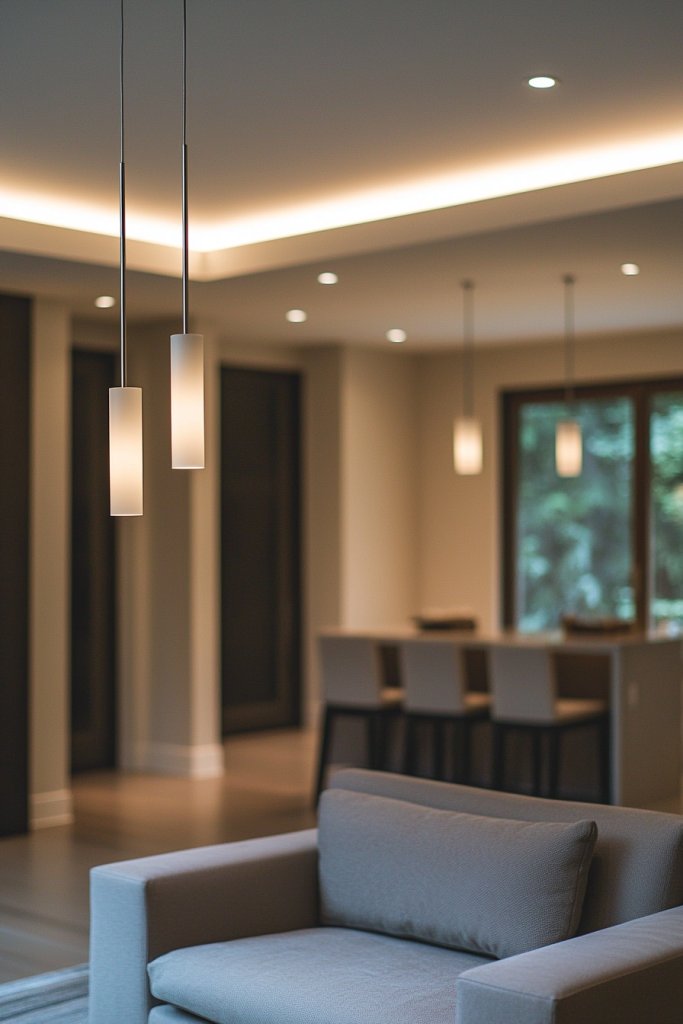
Lighting plays a crucial role in shaping the mood of a minimalist living room, and selecting the right fixtures can transform your space into a tranquil retreat. Opt for sleek, understated designs that provide ample illumination without drawing too much visual attention. Think of pendant lights with smooth, matte finishes, or flush-mounted ceiling fixtures with simple geometric shapes—these create a calm, cohesive glow that enhances the room’s serenity.
Visually, minimalist lighting fixtures are often characterized by clean lines, soft curves, and monochrome finishes like matte black, brushed nickel, or warm brass. When turned on, they emit a gentle, diffused light that softly illuminates the room, creating subtle shadows and emphasizing textures. The space feels open and uncluttered, with each light fixture blending seamlessly into the background—highlighting the room’s architecture rather than competing with it. The overall effect is a peaceful, glare-free environment perfect for unwinding.
To achieve this look, start with a simple pendant light with a smooth, unadorned shade, or a flush-mount fixture with a matte finish. Install dimmer switches to adjust brightness levels, enhancing the calm atmosphere during evenings or relaxing moments. Pair these with minimalist table lamps or wall sconces—think of sleek, cylindrical designs or geometric shapes—placed strategically for task or ambient lighting. Choose warm white bulbs (around 2700K) for a soft, inviting glow, and keep accessories uncluttered to maintain your space’s serene aesthetic.
8. Incorporate Geometric Decor Elements for Visual Simplicity
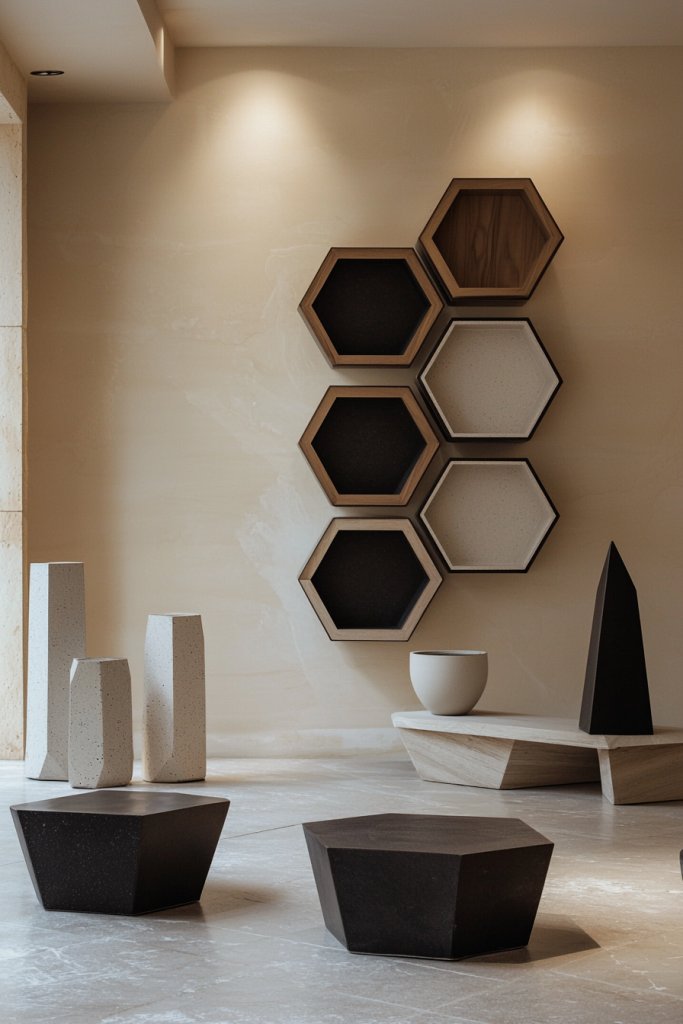
Adding geometric decor elements introduces a modern touch to your minimalist living room while maintaining clarity and order. These shapes—such as triangles, circles, squares, or hexagons—serve as focal points or subtle accents that bring visual interest without chaos. Using geometric objects like ceramic vases, sculptures, or patterned cushions helps create a balanced, cohesive look rooted in simplicity.
Visually, these decor pieces feature sharp lines, clean angles, and repetitive shapes that evoke a sense of harmony and structure. For example, a set of three ceramic vases with rounded, faceted surfaces in neutral tones can sit on a shelf or coffee table, providing a subtle yet captivating focal point. Geometric patterns are also effective on textiles—think of a throw pillow with a black-and-white triangle motif or a rug with a hexagonal pattern—adding visual rhythm without overwhelming the space. The overall aesthetic remains crisp, organized, and calming.
Implementing this idea is straightforward: start with a few geometric-shaped ceramics or sculptures, such as a faceted marble cube or a minimalist metal sphere. Incorporate patterned cushions with geometric prints, and consider framed prints or wall decals featuring simple shapes. These elements can be sourced from home decor stores or online marketplaces, often at affordable prices. Arrange them thoughtfully to create symmetry or intentional asymmetry, always keeping the overall look balanced and uncluttered to preserve your minimalist vibe.
9. Use Monochrome Decor for a Cohesive, Serene Look
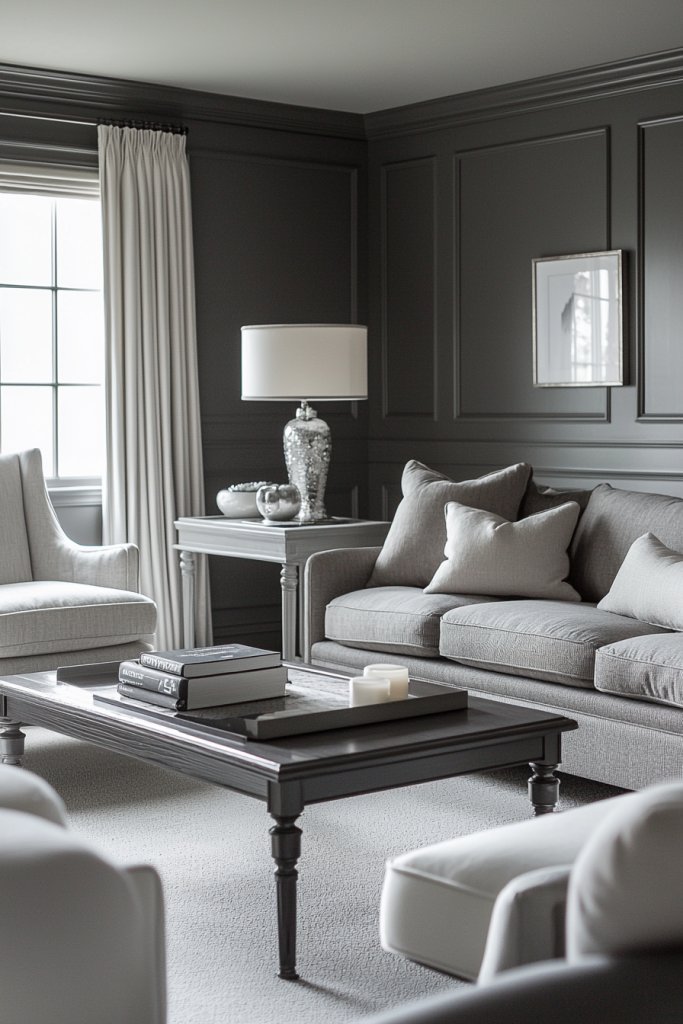
A monochrome decor scheme is a powerful way to cultivate calm and clarity in a minimalist living room. By sticking to a single color palette, you create a seamless, harmonious environment that feels both sophisticated and soothing. Whether you choose shades of white, grey, beige, or muted pastels, this approach minimizes visual distraction and emphasizes clean lines and textures.
Visually, a monochrome space features layered shades of one color—think a palette of soft greys with varying textures, from matte-painted walls to a plush velvety cushion and a smooth ceramic vase. The different tones add depth and interest without breaking the calm. Textures become especially important here: a matte-finish coffee table paired with a silky throw or a shaggy rug in a matching hue creates tactile richness that enhances the visual unity. The overall effect is a serene, uncluttered room that invites relaxation and mindfulness.
To implement this, select a primary color—such as warm beige or cool grey—and choose furnishings, textiles, and decorative objects within that spectrum. Use neutral-colored cushions, throws, and rugs with varying textures to add depth. Incorporate complementary materials like wood, metal, or ceramics in similar shades to maintain cohesion. Keep accessories minimal—perhaps a single sculptural object or a sleek lamp—ensuring each piece contributes to the unified aesthetic. This approach makes your space feel open, airy, and effortlessly elegant.
10. Keep Surfaces Clear of Excess Items for a Clean Appearance
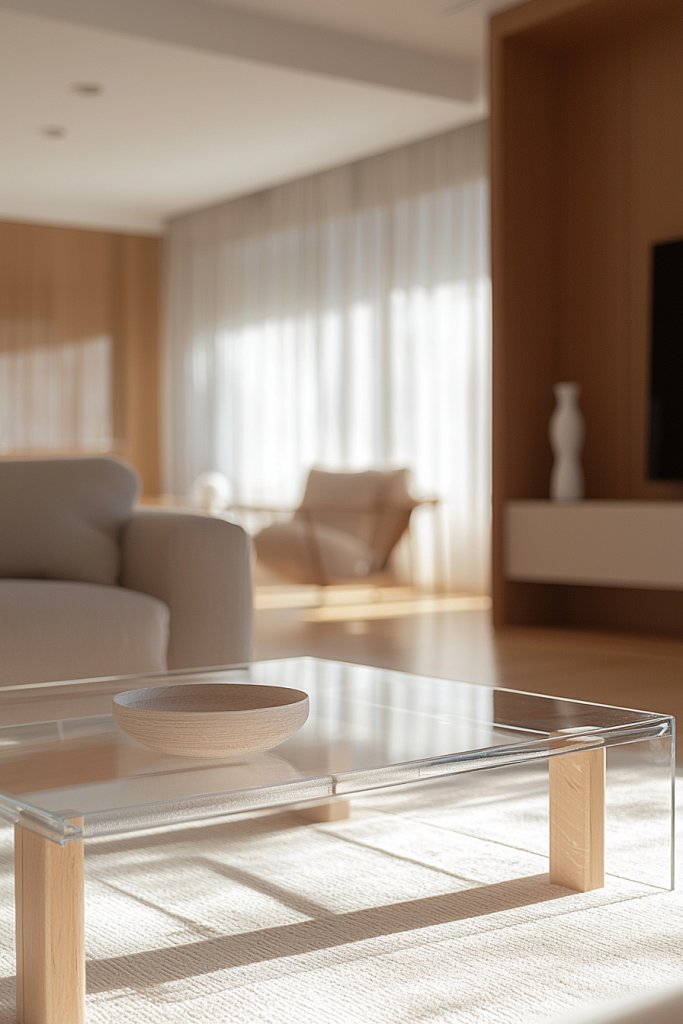
Achieving true calm in a minimalist living room hinges on maintaining clutter-free surfaces. Clear countertops, coffee tables, and shelves create a sense of order and allow the carefully selected decor and furniture to shine. This principle emphasizes quality over quantity, encouraging you to only display essentials or meaningful objects, which reinforces a peaceful, uncluttered environment.
Visually, this means surfaces are almost empty—perhaps a single ceramic tray on the coffee table, a sleek lamp, or a minimalist vase. When surfaces are free of excess, the eye can focus on the few well-chosen objects, which act as visual anchors. The room feels larger and more open, with light bouncing off clean surfaces, enhancing the sense of clarity. The overall atmosphere is one of quiet sophistication, where every item has a purpose and space to breathe.
Practically, start by sorting through your surfaces and removing everything that isn’t necessary or doesn’t bring you joy. Use storage boxes or trays to hide away small items and keep only a few impactful decor pieces in sight. Regularly revisit and tidy these surfaces to prevent accumulation of clutter. Incorporate multi-purpose furniture with built-in storage, like ottomans or side tables, to help keep everything organized and out of sight. A minimal, tidy surface not only looks better but also creates a calming environment that’s easy to maintain daily.
11. Integrate Built-In Shelves to Maintain a Clutter-Free Environment

Creating a clutter-free living room is essential for achieving a minimalist, calming space, and built-in shelves are a perfect solution. They seamlessly blend into your walls, providing discreet storage that keeps everyday items out of sight while showcasing your favorite essentials. This approach not only maximizes space but also elevates the room’s sleek, streamlined aesthetic, making your environment feel open and organized.
Visualize a wall with recessed shelves painted in a soft matte white, perfectly integrated into the wall itself. The shelves hold neatly stacked books, minimalist ceramics, and a few carefully selected decorative objects like textured vases or small sculptures. The design maintains clean lines and avoids visual clutter, with everything arranged in a balanced, intentional manner. The overall effect is a serene backdrop that feels spacious, with each item adding subtle interest without overwhelming the senses.
To implement built-in shelves, start by assessing your wall space and deciding on the depth and height of the shelves. You can hire a carpenter or follow DIY tutorials using plywood or MDF, which you can paint or veneer in your preferred neutral tone. Install the shelves at varying heights for visual interest, but keep the arrangement simple. Remember to keep the top surfaces clear of unnecessary items, and choose a few favorite decorative pieces that align with your minimalist style for an effortlessly elegant look.
12. Select Simple, Unadorned Window Treatments for Natural Light Control

Minimalist living rooms thrive on natural light, and choosing uncomplicated window treatments is key to maintaining a clean, airy vibe. Avoid heavy drapes or ornate curtains; instead, opt for simple, unadorned options like roller blinds, sheer panels, or sleek roller shades. These allow you to control light while preserving the room’s uncluttered aesthetic, making the space feel fresh and open.
Imagine a large window framed by crisp, white linen roller shades that can be pulled up to reveal expansive views or lowered for privacy. The sheer fabric gently diffuses sunlight, casting a soft glow that enhances the room’s calm atmosphere. The absence of decorative fringes or embellishments keeps the look understated, allowing the focus to remain on the room’s clean lines and neutral palette. These treatments create a seamless connection between indoors and outdoors, amplifying the spacious feel.
To choose the right window treatments, measure your windows accurately and select a simple, high-quality fabric in neutral tones such as white, beige, or light gray. Roller shades are easy to install and operate, and they come in various opacity levels—from sheer to blackout—to suit your needs. For added simplicity, opt for motorized or cordless options for a sleek, clutter-free appearance. Keep treatments minimal and functional, enhancing the room’s sense of calm and clarity.
13. Use Open-Back Shelving to Display Essential Items Elegantly
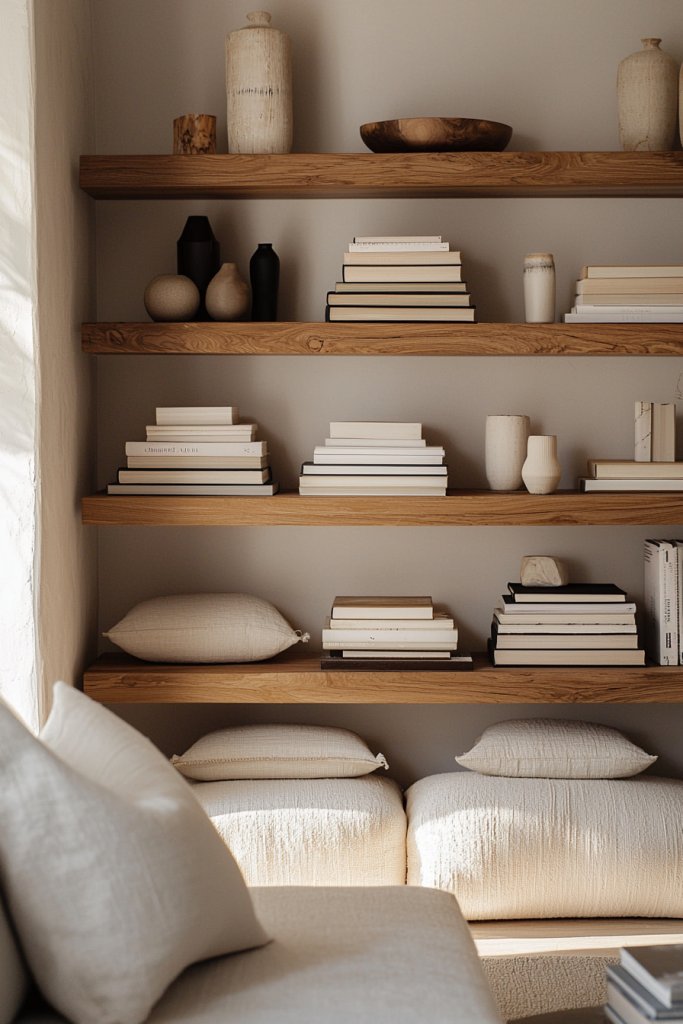
Open-back shelving offers a stylish way to keep essentials accessible while maintaining an airy, minimalist look. These shelves are perfect for displaying everyday items like tableware, books, or decorative objects without creating visual heaviness. Their open design creates a sense of lightness and allows for easy organization, contributing to the overall sense of calm.
Picture a set of open-back shelves painted in matte black or natural wood, with neatly arranged white dishes, minimalist vases, and a few carefully curated decor pieces like small ceramic sculptures or textured bowls. The open design ensures the space doesn’t feel crowded, and the absence of back panels allows light to pass through, enhancing the sense of openness. Each item is thoughtfully placed to avoid clutter, creating a balanced, curated look that feels both functional and aesthetic.
To incorporate open-back shelving, select units made from simple materials like wood or metal, and choose a size that fits your space without overwhelming it. Arrange items in a way that balances visual weight, mixing taller objects with smaller ones. Keep the shelves tidy and avoid overcrowding—less is more in a minimalist setting. Use these shelves to showcase favorite items that contribute to your calming, uncluttered living space.
14. Incorporate Sculptural Decor for Artistic Focus Without Overload
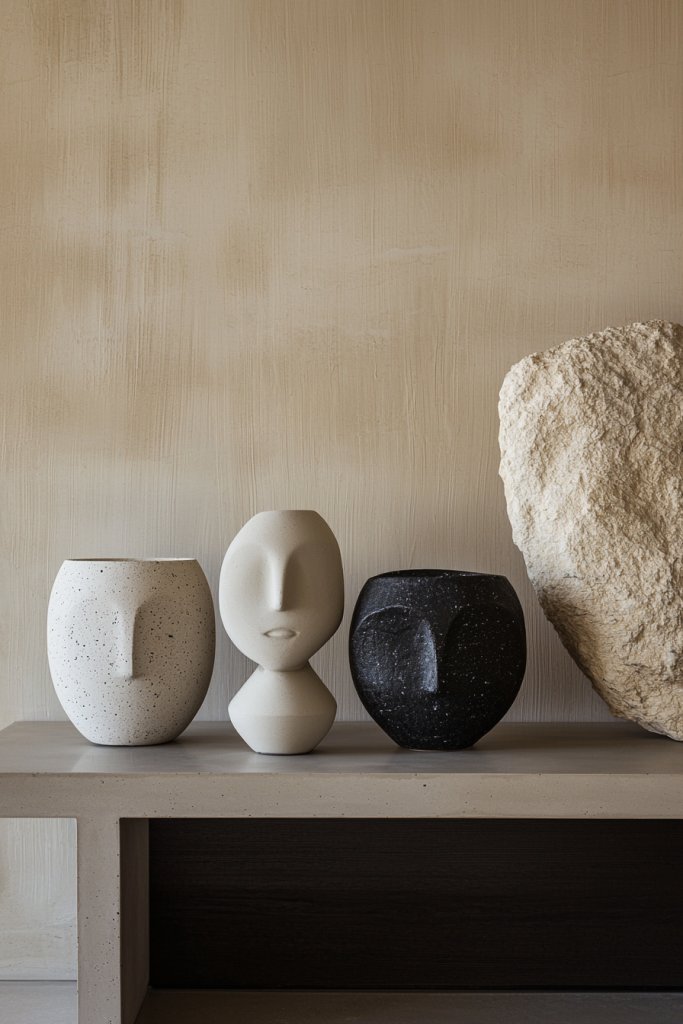
Adding sculptural decor introduces artistic interest into your minimalist living room without cluttering the space. These objects serve as focal points, adding texture and visual intrigue through clean, simple forms. Sculptures or decorative objects made from materials like ceramic, wood, or metal can elevate the room’s aesthetic while maintaining the overall sense of clarity and calm.
Visualize a smooth, abstract ceramic sculpture on a low table or a sleek metal sculpture placed on a shelf. These pieces have bold, geometric shapes that draw the eye but are restrained enough not to disrupt the minimalist vibe. The textures—matte, polished, or raw—add depth and tactile interest to the room. When chosen thoughtfully, sculptural decor becomes a subtle yet powerful statement that enhances the space’s artistic and tranquil qualities.
To incorporate sculptural decor, start by selecting pieces with simple geometric or organic forms that resonate with your aesthetic. Place them on side tables, shelves, or mantels, ensuring each piece has enough space around it to be appreciated. Keep the number of sculptures minimal—one or two well-chosen objects are enough to create a striking focal point. Focus on quality and form to ensure these decor pieces add sophistication without overcrowding your minimalist sanctuary.
15. Choose Minimalist Art Prints for Subtle Visual Interest

In a minimalist living room, art plays a crucial role in adding visual interest while preserving the serene atmosphere. Opting for minimalist art prints—think monochrome geometric designs, abstract lines, or subtle color gradients—can subtly enhance the space without overwhelming it. These pieces serve as quiet accents that complement the room’s calm, cohesive look.
Imagine a large, monochrome print featuring simple black lines on a white background, framed in a slim, matte black frame. It hangs on a neutral wall, adding a focal point that’s visually engaging yet understated. The subtle variation in texture and tone invites closer inspection, providing visual depth without disrupting the room’s tranquility. These prints create a cohesive, sophisticated look that feels effortless and intentional.
To choose the right art prints, look for high-quality images that resonate with your style—consider affordable options from online print shops or even DIY digital prints. Select frames in neutral finishes like black, white, or natural wood to keep the look clean. Hang your artwork at eye level above key furniture pieces, and keep framing simple to preserve the minimalist aesthetic. This approach ensures your living room remains calm, cohesive, and subtly captivating.
16. Maintain a Consistent Material Palette for Cohesion

Creating a cohesive minimalist living room starts with selecting a unified material palette that ties the space together seamlessly. When your furniture, textiles, and decor share similar finishes or textures, the room feels more harmonious and calming. For example, pairing matte oak wood furniture with woven linen cushions and ceramic vases in neutral tones creates a subtle, elegant flow. This consistency minimizes visual clutter and helps the eye move smoothly across the space, emphasizing calm and order.
Visually, imagine a living room where the sofa features a soft, muted beige fabric, complemented by a coffee table with a matte wood finish and matching side tables. Textures are kept simple—smooth ceramics, brushed metals, and natural fibers—creating a tactile experience that invites relaxation. The color tones are kept within the same warm or cool spectrum, avoiding jarring contrasts. This approach enhances the overall sense of tranquility, making the room feel curated yet effortless.
To implement this, start by choosing a primary material—such as light oak, concrete, or linen—and carry it through your key pieces. Opt for furniture with similar finishes and avoid mixing too many different textures or colors. If budget is a concern, look for versatile materials like bamboo or recycled plastics that mimic natural textures. Keep your decor and textiles in complementary hues to maintain visual flow, creating a serene environment that feels both intentional and soothing.
17. Opt for Invisible or Floating Furniture to Enhance Space Perception
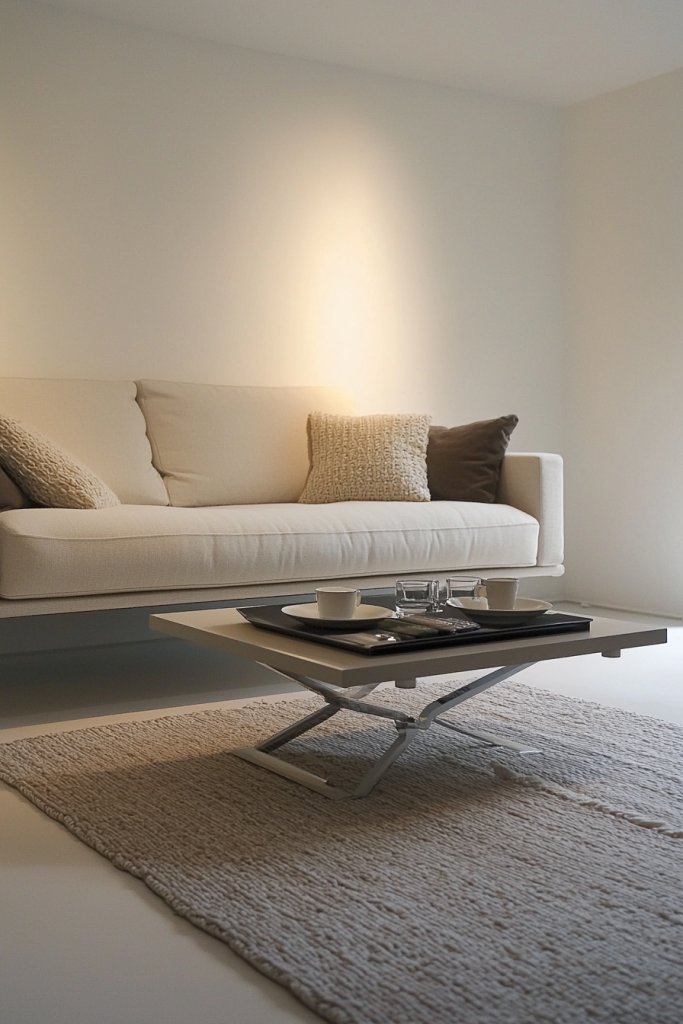
Floating or invisible furniture pieces are a game-changer in small, minimalist apartments because they give the illusion of more space and reduce visual weight. These pieces appear to hover above the floor, creating a sleek, modern aesthetic that emphasizes openness. For example, a wall-mounted TV unit or floating shelves not only save precious floor space but also make the room look less crowded and more airy.
Picture a living room with a wall-mounted media console, with clean lines and no visible legs, paired with a sofa that appears to be floating thanks to sleek, concealed legs or a low-profile design. Light-colored or matte finishes further enhance the seamless, uncluttered look. The absence of bulky furniture allows natural light to flow freely, making the space feel expansive and calm. This setup encourages a sense of lightness, perfect for a minimalist vibe.
To achieve this, choose furniture with hidden or minimal supports—think floating shelves, wall-mounted cabinets, or sleek modular units. For seating, look for low-profile sofas with slender legs or no legs at all, which can be found in many modern furniture stores or DIY options. When installing, ensure proper wall anchors and secure mounting to guarantee safety and stability. This approach creates an uncluttered, spacious feel that transforms your apartment into a calming retreat.
18. Use Mirrors to Create Depth and Reflect Light
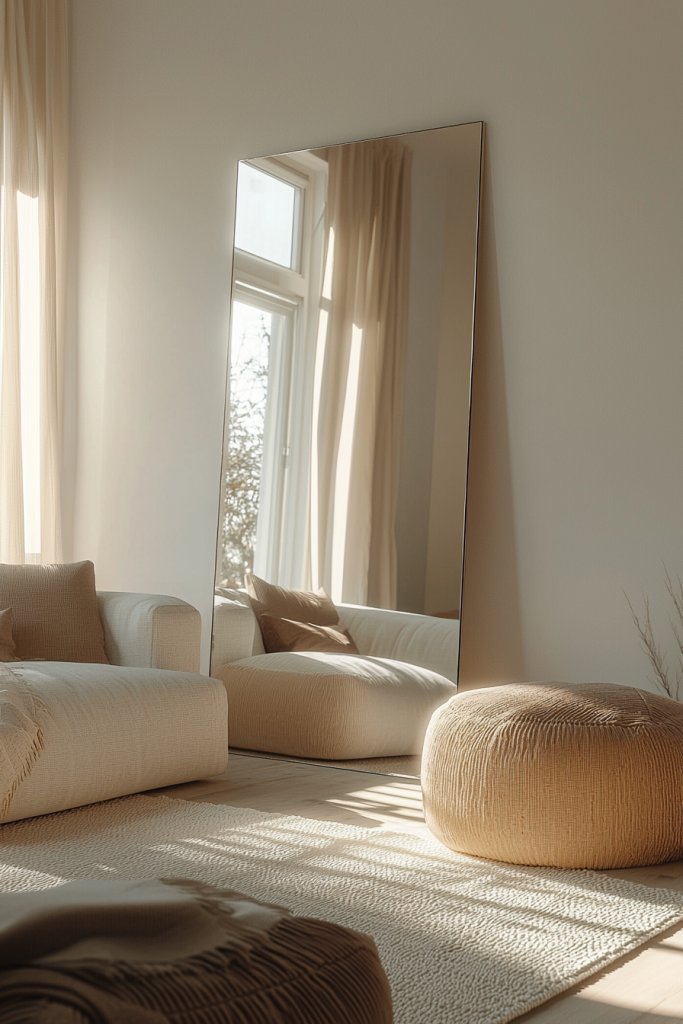
Mirrors are essential in minimalist living rooms because they add depth and reflect light, making small spaces appear larger and brighter. A well-placed mirror can double the visual space, bouncing natural daylight across the room and reducing the need for multiple light sources. For a sleek look, opt for frameless or minimal-frame mirrors that blend seamlessly into the decor.
Imagine a large rectangular mirror mounted above a console table, reflecting the soft glow of a nearby window. The mirror’s sleek, simple frame complements the neutral color palette and clean lines of the furniture. The reflective surface adds a sense of openness, while also highlighting textures like a plush throw or textured rug. The overall effect is a space that feels airy, inviting, and uncluttered, with a calming atmosphere enhanced by light and reflection.
To incorporate mirrors, position one opposite a window or in a corner that catches natural light. For versatility, use full-length mirrors for a functional touch or smaller decorative ones as accents. Choose simple, unobtrusive frames or frameless designs for a minimalist aesthetic. Regularly clean the mirror to maintain its reflective clarity, ensuring it continues to brighten your living space and create a sense of calm and clarity.
19. Incorporate Subtle Accent Colors for Visual Calm

Adding subtle accent colors is a strategic way to introduce visual interest into a minimalist living room without overwhelming the senses. Soft hues like blush pink, muted teal, or gentle mustard can create focal points that feel calming and sophisticated. These colors work best when used sparingly—on cushions, throws, or small decorative objects—allowing the overall neutral palette to remain dominant.
Visualize a living room with a palette of warm greys and creams, accented by a single pastel blue throw blanket draped over a sleek sofa. A few ceramic vases in soft blush or pastel green sit on a shelf, adding delicate pops of color. The subtle contrast draws the eye without disrupting the sense of serenity, creating a balanced environment that feels both intentional and restful. Textures like velvet or matte ceramics enhance the softness of the accent hues.
To implement, select one or two gentle colors that complement your neutral base. Use these on small decor items or textiles—like cushions, rugs, or decorative bowls—to introduce variety without clutter. Keep larger furniture pieces in neutral shades to maintain calm, and let the accents serve as gentle visual anchors. This approach adds depth and personality to your space while preserving the clarity and simplicity central to minimalist living.
20. Utilize Matte Finishes on Furniture and Decor for a Soft Look

Matte finishes are key to achieving a soft, understated aesthetic in a minimalist living room. Unlike glossy surfaces, matte materials absorb light rather than reflect it, creating a gentle, soothing visual effect. This finish adds depth and texture, making furniture and decor feel more tactile and inviting, perfect for a calm and relaxing environment.
Imagine a velvet-upholstered armchair with a matte, brushed metal side table and matte ceramic vases. The muted finishes reduce glare, allowing the subtle textures of linen cushions or woven rugs to stand out. The overall atmosphere feels warm and serene, with surfaces that invite touch and exploration without overwhelming the senses. Matte finishes also minimize fingerprints and scratches, maintaining a pristine look over time.
To incorporate matte finishes, opt for furniture with powder-coated metal, matte wood, or ceramic surfaces. Choose decor items like vases, picture frames, or lamps in matte finishes to unify the look. When shopping, look for labels specifying “matte” or “satin” to ensure you get the soft, non-reflective effect. This subtle touch elevates your space’s calm, cohesive vibe, making it both stylish and easy to maintain.
21. Create Defined Zones with Area Rugs for Organized Spaces

Creating clearly defined zones within a minimalist living room helps foster calm and order, making the space feel more organized and purposeful. This approach prevents the room from appearing cluttered, even when multiple functions are needed, and visually guides the eye through the space. It’s especially useful in open floor plans, where distinct areas like seating, dining, or workspace need subtle separation.
Imagine a plush, neutral-toned area rug anchoring your seating area—perhaps a soft beige or muted gray with a subtle geometric pattern—delineating the space without overwhelming it. Complement this with sleek, low-profile furniture that sits comfortably on the rug, such as a streamlined sectional sofa and a minimalist coffee table. Use different textures or slight color variations to distinguish zones, like a cozy, woven rug in front of the sofa and a smooth, low-pile one in a workspace corner. The layered textures add visual interest while maintaining the calm, cohesive look. The overall effect is a harmonious space where each zone feels intentional, and the transitions are seamless.
To implement this, start by measuring your room to determine the ideal rug size for each zone. Choose a low-pile wool or cotton rug for comfort and durability—alternatives include jute or synthetic fibers for budget options. Place the rug under key furniture pieces so that at least the front legs sit on it, creating a natural boundary. Keep surfaces clear and avoid excessive clutter within each zone, allowing the defined spaces to breathe. This simple step turns a chaotic room into an organized retreat that promotes relaxation and clarity.
22. Keep Decorative Accessories to a Minimum for a Breathable Environment
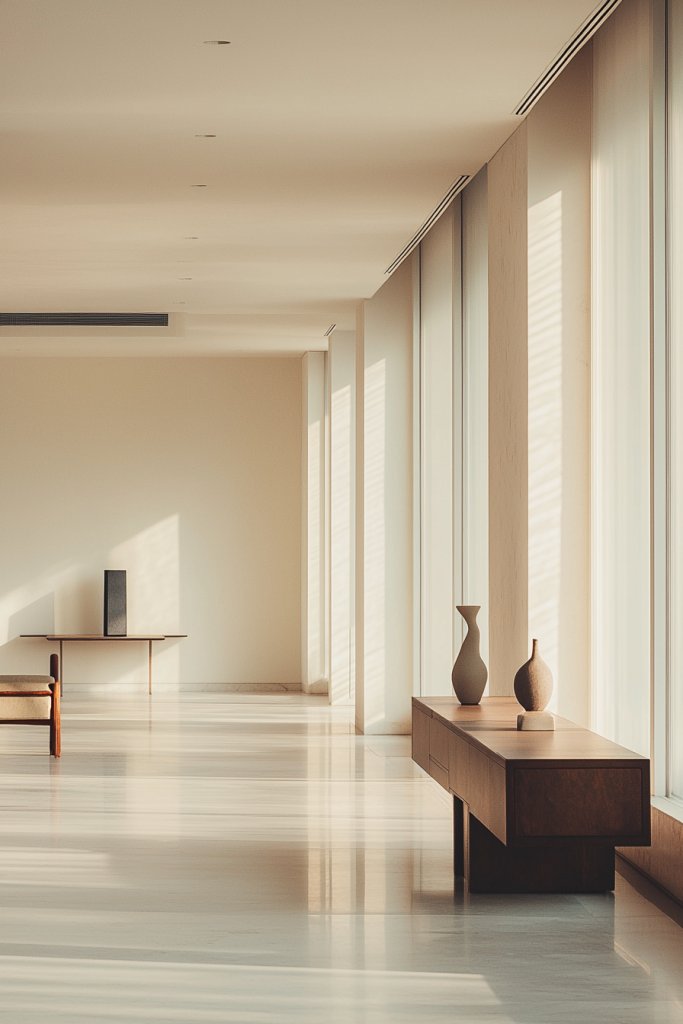
In a minimalist living room, less truly is more—especially when it comes to decorative accessories. Limiting the number of decorative objects helps prevent visual clutter, making the space feel open, calm, and easy to relax in. Carefully selected accessories become focal points rather than distractions, allowing the room’s clean lines and subtle textures to shine.
Picture a few thoughtfully chosen items: a sleek ceramic vase on a side table, a minimalist sculpture on a shelf, or a simple, elegant bowl for keys. These objects should complement the overall neutral palette—think matte black, soft stone, or muted metallic finishes—adding visual interest without overwhelming the senses. Keep surfaces like coffee tables, shelves, and mantels mostly clear, with only one or two meaningful pieces per surface. The goal is to create a sense of openness and serenity, where every object has space to breathe and contribute to the room’s calm atmosphere.
To achieve this, start by editing your existing decor—remove excess items and select a small number of meaningful accessories. Focus on quality over quantity, opting for timeless pieces that can serve multiple purposes or hold sentimental value. Use storage solutions like minimalistic boxes or trays to hide away rarely used items, maintaining a tidy surface. Regularly reassess your space, removing anything that doesn’t add to the room’s serenity, and resist the urge to fill every available surface with decor—less truly makes a room feel more expansive and peaceful.
Conclusion
By embracing neutral palettes, clever storage solutions, multi-functional furniture, and thoughtful decor choices, you can transform your apartment into a serene haven of simplicity and clarity. These minimalist ideas empower you to create a living space that feels open, calm, and effortlessly stylish. Don’t hesitate to incorporate these tips and craft a peaceful environment that reflects your personal style. Start today—your calm, clutter-free living room awaits!
Leave a Reply